Model Predictive Control of Piecewise Affine System with Constrained Input and Time Delay
Abstract
A model predictive control (MPC) is proposed for the piecewise affine (PWA) systems with constrained input and time delay. The corresponding operating region of the considered systems in state space is described as ellipsoid which can be characterized by a set of vector inequalities. And the constrained control input of the considered systems is solved in terms of linear matrix inequalities (LMIs). An MPC controller is designed that will move the PWA system with time delay from the current operating point to the desired one. Multiple objective functions are used to relax the monotonically decreasing condition of the Lyapunov function when the control algorithm switches from a quasi-infinite horizon to an infinite horizon strategy. The simulation results verify the effectiveness of the proposed method. It is shown that, based on LMI constraints, it is easy to get the MPC for the PWA systems with time delay. Moreover, it is suitable for practical application.
1. Introduction
In engineering practice, there are many hybrid systems described by piecewise affine systems (PWA) which are composed of linear subsystems and convex polytopic regions. Hybrid systems are composed of discrete event dynamic systems and continuous time dynamic systems or discrete time dynamic systems, which interact with each other [1]. The hybrid system theory, which is proposed for the demand of the economic development, is the result of the development of computer science and control theory. Piecewise affine system is one of the most important branches of hybrid system [2]. It consists of some subsystems that integrate the logical and continuous dynamics by switching. Theoretically, any nonlinear system can be approximated as piecewise affine system [3, 4]. In [5], the PWA system is described as ellipsoid which can be characterized by a set of vector inequalities. In [6], the constraint of linear matrix inequalities (LMIs) is released. In terms of LMIs, the PWA system can be stabilized in Lyapunov theory.
Model predictive control (MPC), also known as receding horizon control, is a popular technique for the control of dynamical systems, such as those encountered in chemical process control in the petrochemical, pulp and paper industries, and in industrial hot strip mill [7]. MPC is also a popular technique for the control of dynamical system subject to input and state constraints. At any time instant, MPC requires the online solution of an optimization problem to compute-optimal control inputs over a fixed number of future time instants, known as the finite horizon or quasi-infinite horizon. Using MPC, it is possible to handle inequality constraints on the manipulated and controlled variables in a systematic manner during the design and implementation of the controller [8, 9]. MPC has become the control strategy of choice in industrial applications that typically involve linear systems subject to linear inequality constraints. However, industrial processes are in general inherently nonlinear and operated over a wide range of operating conditions [10, 11]. The use of multiple model/controllers is a common strategy in dealing with the complex of nonlinear systems and has led to the development of various multiple model/controller approaches. Considerable research has been focused on the development and utilization of multiple model/controller banks within the MPC framework [12–14] in order to cope with nonlinear systems. The basis of these approaches is the decomposition of the systems full range of operation into a number of operating regimes in which a simpler local model and/or controller is applied. The local models and controllers are then incorporated to give a global model and/or controller.
Closed-loop stability in multiple model/control approaches has also been studied [15] since designing local controllers that stabilize each individual model may not result in a stable global closed-loop system. In general, the use of piecewise models in a control structure necessitates a means of switching among the available models to the one that best describes the current process dynamics. The switching from one model/controller to another based on a logical argument (supervisory scheme) results in a hybrid system. A closely related work is the stability analysis of piecewise linear systems by [16] in which piecewise quadratic Lyapunov functions were constructed using convex optimization in terms of linear matrix inequalities (LMIs) as an alternative to a globally quadratic Lyapunov function.
Time delay systems are very common in industry. However, few works on control algorithms development for time delay PWA system have been reported [17, 18]. Based on this concept, we propose a MPC control algorithms for the discrete polytopic time-delay PWA systems. The MPC controller of the considered systems is solved in terms of LMIs. The sufficient conditions of stability are derived for time-delay systems. The feedback control law is obtained by convex optimization involving LMIs. The simulation results verify the effectiveness of the proposed method.
2. Problem Formulation
Problem 1. Find a piecewise affine state feedback controller that exponentially stabilizes the PWA system when x(k) ∈ Xi, x(k + 1) ∈ Xi.
Problem 2. It is the same as Problem 1 at the switching moment when x(k) ∈ Xi, x(k + 1) ∈ Xi+1.
Lemma 3. The state region Xi can be described as same ellipsoids Xi⊆ɛi, where ɛi = {x∣∥Eix + ei∥ ≤ 1}. Denote the ellipsoid Xi as the quadratic inequalities (see [5]):
Assumption 4. In application of this formulation to multiple regions, we assume that we know the order of regions that the states will go through starting from the current region of the system to the terminal region.
Assumption 5. We also assume that we know the number of moves that the system has to take to go from one region to another adjacent operating region.
3. Main Result
In this section, the problem formulation for MPC using piecewise linear models of the form (2) is discussed. The aim is to find a sequence of control input signals u(k + n∣k) that will move the system from the current operating point to the desired one. The authors of [19] presented an MPC design technique (min-max MPC) in which the minimization of the nominal objective function was modified to a minimization of the worst case objective function. In this work, we extend this formulation using piecewise affine model with time delay.
Theorem 6. Consider a time-delay PWA system (2) with several operating points, where i denotes the active PWA model and Xi+1 shows the corresponding operating region which if described by |Ei+1x + ei+1| ≤ 1 with x ∈ Xi+1. u(k∣k) ⋯ u(k + n∣k) are sequences of control inputs to the PWA system. The states of PWA system (2) are steered from Xi to X(i+1) in n steps, where n is control horizon constant. If there exist Yi+1 = Ki+1Q, Q ≥ 0, W > 0, γ > 0, ξ > 0, and a sequence of u(k∣k) ⋯ u(k + n∣k) satisfy the following LMI (12)–(16), the sequence of control input signals will move the system from the current operating region to the desired one, until to the origin of the system.
Proof (1) Upper Bound on the Objective Function. The objective function can be split into two parts:
(2) The Stability of Inequality with Ellipsoids Constraints. In this section, the aim is to design an MPC controller in which the minimization of the nominal objective function was modified to a minimization of the worst case objective function. A thorough discussion of the previous problems can be found in [19]. The objective function of MPC in [19] is
Substituting (20) into (21) gives
(3) Input Constraints. It is also possible to incorporate input constraints. We consider bounds on input at time k such as
(1) If PWA does not switches to the terminal operating ellipsoid region, the sequences u(k + m∣k), m = 0 … n are free variables satisfying |u(k + m)| ≤ umax , m = 0 … n.
(2) If PWA switch to the terminal operating ellipsoid region,
Using the previous techniques, the problem of minimizing an upper bound on the worst-case objective function, subject to input and terminal operating ellipsoid constraints, is reduced to a convex optimization of {u(k∣k), u(k + 1∣k) ⋯ u(k + n∣k), Ut} in terms of LMIs (12)–(16).
Remark 7. Although derived for a time-delay PWA system with ellipsoidal partitions, the optimization problem LMI (16) gives a feasible solution only when , which means the ellipsoidal region Xi does not contain origin [5]. When the ellipsoidal region contains origin, it is assumed that bi = 0. For convenient notion, we get LMI (16) as follows:
4. Simulation Result
4.1. Example for Autonomous Land Vehicle
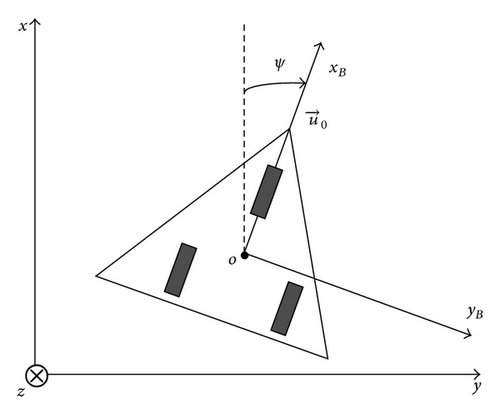
τ = 2 is the time-delay constant. We construct the discrete system by sampling T = 0.02 s, and initial state x(0) = x(−1) = x(−2) = [π/2,0, 3] T. By applying Theorem 6, we get the simulation results.
Figures 2 and 3 are the simulation results. Figure 2 shows the state response of the PWA system with time delay. Obviously, all of the states are stable. Figure 3 shows control input action. Physical limitations in ALV impose hard constraints on the torque input. The simulation result in Figure 3 shows that state feedback control strategy can stabilize the PWA system with time-delay subject to input constraints. In this section, the simulation shows the specified constraints on the torque input variable are satisfied.
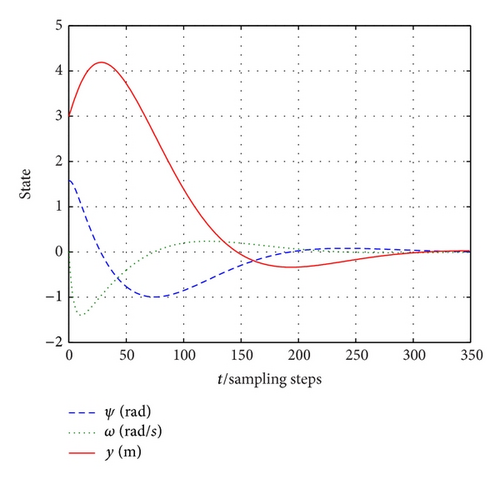
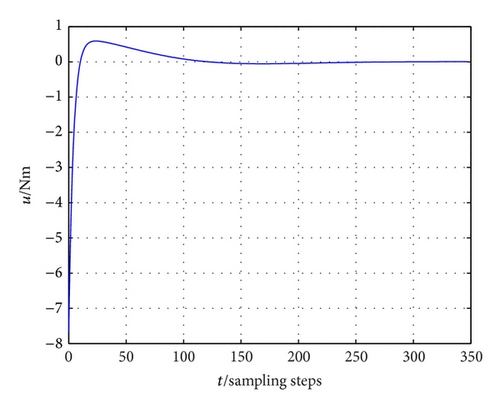
4.2. Example for Nonlinear Circuit
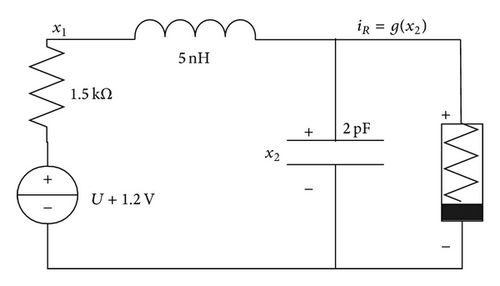
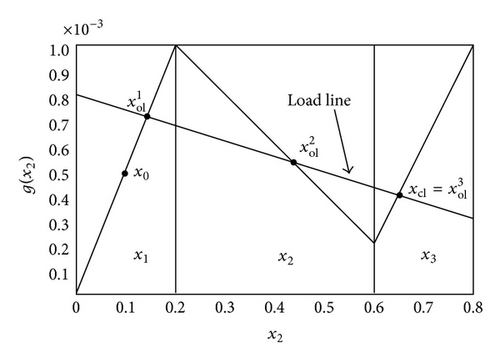
Figures 6 and 7 show the state response of the PWA system with time delay. Trajectory of the current and voltage shows that the original states are steered from X1 to close-loop equilibrium in X3. Obviously, all of the states are stable. Figure 8 shows the control input action. The simulation result shows that state feedback control strategy can stabilize the PWA system with time delay subject to ellipsoid constraints. Moreover, the constraint on the control input is satisfied.
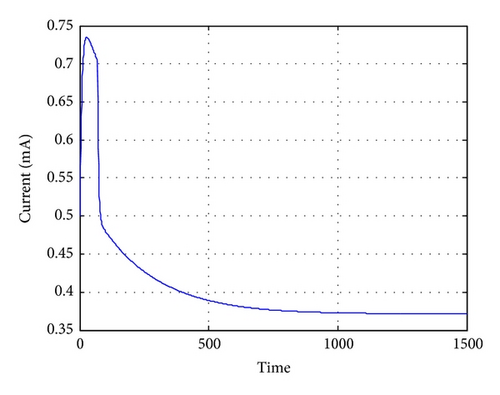
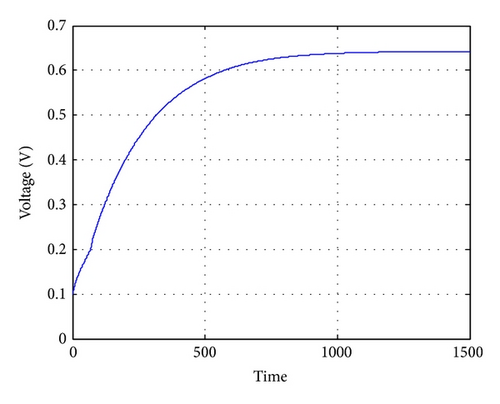

5. Conclusion
This work presented a stabilizing multimodel predictive control algorithm which has a contractive constraint to guarantee closed-loop stability. Moreover, the stability of the closed-loop is analyzed by employing the Lyapunov functions approach. Depending on the system state (in the terminal region or outside) the corresponding Lyapunov functions are assigned. The use of multiple objective functions has enabled us to relax the monotonically decreasing condition of the Lyapunov function when the control algorithm switches from a quasi-infinite horizon to an infinite horizon strategy. We have developed a new controller design technique for MPC of piecewise affine systems with time-delay and input constraints. The two simulation examples proposed in Section 4 show that the driving moment (in example 1) and control voltage (in example 2) are limited in amplitude, which makes MPC approach a natural choice for the design of the controller with hard constraints. The technique in this paper leads to convex LMIs based online optimization problem when the local operating regions of the piecewise linear model family are described by ellipsoids. Perhaps the principal shortcoming of MPC proposed is their inability to explicitly incorporate plant model uncertainty. MPC involving data-driven technique is suitable to overcome the previous problem [7, 10, 11, 22, 23]. And it should also be noted that the controller proposed in this paper is developed with known order of regions. In the future work, efforts will be made to design the data-driven MPC controller with uncertain model parameters and switching order.
Acknowledgments
The authors are grateful to the reviewers for their valuable comments. This work is partially supported by National Natural Science Foundation of China (51379044, 61304060, 61201410, and 61104037), Fundamental Research Funds for the Central Universities (HEUCF130804), and Heilongjiang Province Natural Science Foundation Projects (F200916).




